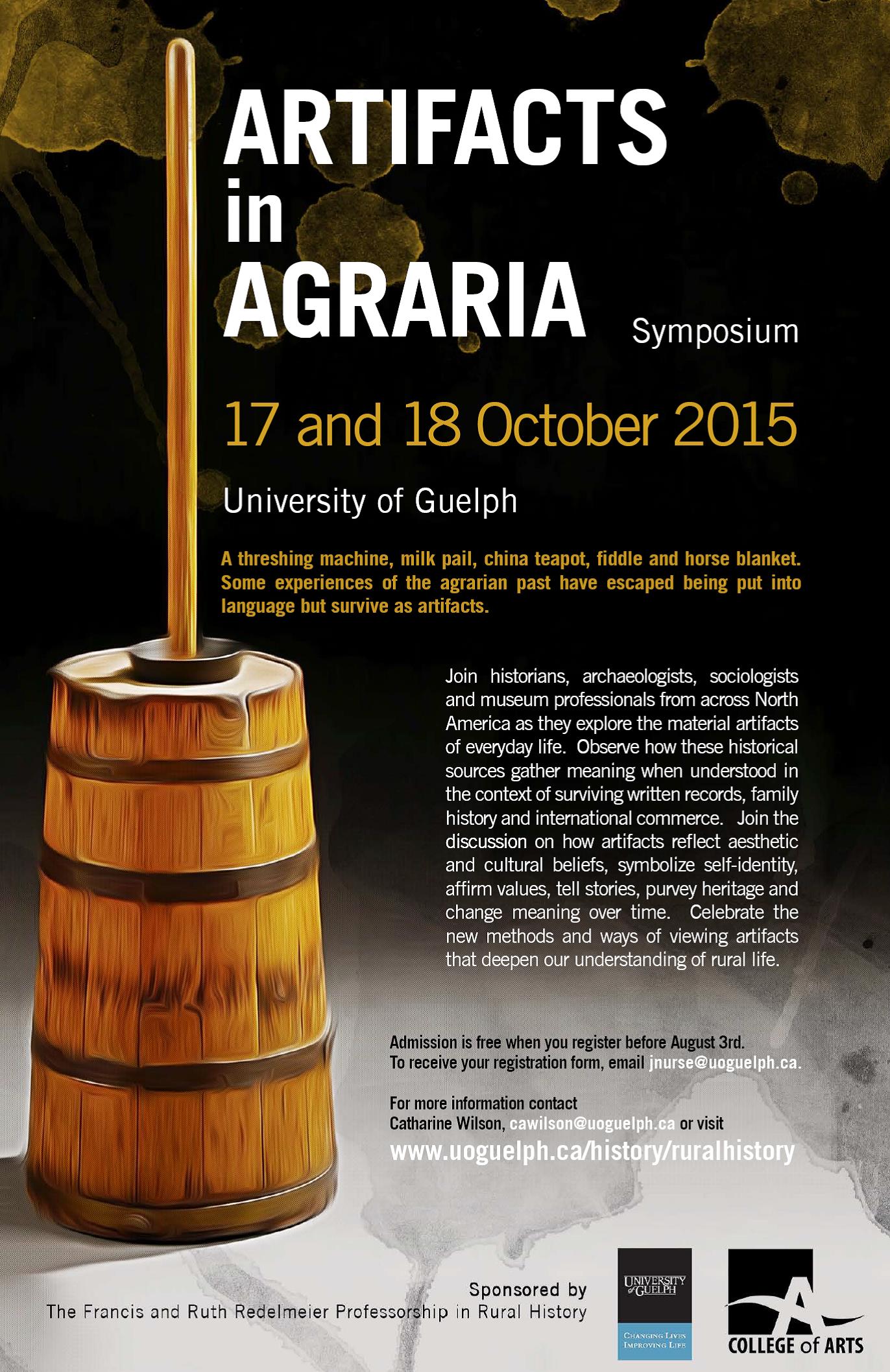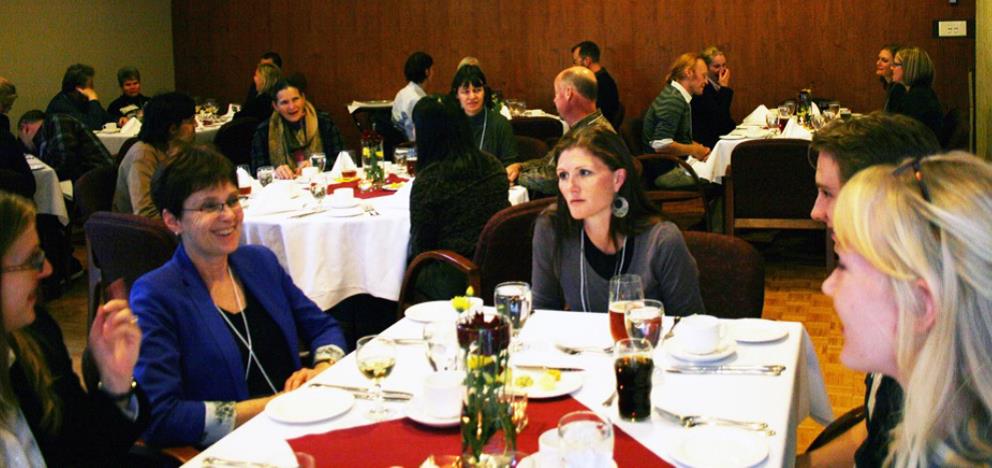Rural Women and their Things: Thoughts on the 2015 Artifacts in Agraria Symposium
By Jodey Nurse-Gupta
 On October 17th and 18th, 2015, Artifacts in Agraria Symposium participants gathered to hear scholars share their research on various artifacts related to rural history. Each presenter began with an artifact and analyzed how it reflected cultural beliefs, symbolized identity, affirmed values, told stories, and changed meaning over time. Well known Canadian historians like Jack Little, Royden Loewen, Douglas McCalla, Ruth Sandwell, and Catharine Wilson joined other specialists in agricultural history, rural sociology, archaeology, and material culture who came from across Canada and as far away as Atlanta and Oklahoma. A horse blanket, oxen yoke, kerosene lamp, steel wheel, de-horning shears, gourd rattle, milking machine, fiddle and quilt were just some of the artifacts explored, and each presenter conveyed the broader historical significance of their object, as well as its particular importance to rural people in the past.
On October 17th and 18th, 2015, Artifacts in Agraria Symposium participants gathered to hear scholars share their research on various artifacts related to rural history. Each presenter began with an artifact and analyzed how it reflected cultural beliefs, symbolized identity, affirmed values, told stories, and changed meaning over time. Well known Canadian historians like Jack Little, Royden Loewen, Douglas McCalla, Ruth Sandwell, and Catharine Wilson joined other specialists in agricultural history, rural sociology, archaeology, and material culture who came from across Canada and as far away as Atlanta and Oklahoma. A horse blanket, oxen yoke, kerosene lamp, steel wheel, de-horning shears, gourd rattle, milking machine, fiddle and quilt were just some of the artifacts explored, and each presenter conveyed the broader historical significance of their object, as well as its particular importance to rural people in the past.
This symposium emphasized how an artifact can be another important tool for historical analysis. For scholars studying rural women, artifacts can be especially important because finding documentary sources on rural women’s lives can be difficult, so any historical evidence that allows us to consider how they thought, worked, and lived is significant. I have previously written about how objects have benefited my own research on rural women, and the papers presented at the Artifacts in Agraria Symposium further solidified my belief that material cultural studies are necessary when telling the story of rural women’s lives.

Many scholars presenting at the symposium focused on artifacts made or used by women. Andrea Gal showed how canning sealers allowed farm women in the first half of the twentieth century to work alongside their male kin to produce homemade foodstuffs for their family and friends. Meredith Quaile studied nineteenth-century milking machines to show how, despite the desire for an invention that would transform milking from a feminine to a masculine chore, the flawed technology resulted in women’s continued dairy work. In Aileen Friesen’s paper on Mennonite women in Siberia, she explained that milking was very much women’s work. Images of full milk pails were used by Soviets officials to highlight Mennonite women’s success within the Soviet structure. Yet, for the women themselves, full milk pails were ultimately a symbol of their commitment to serving God through their work, not the Soviet Union. Other objects like the sidesaddle signified the social expectations placed on women. Equine etiquette was used to place limits on female behaviour, but, as Tracey Hanshew showed in her paper, the women settling the American West often refused the use of the sidesaddle, preferring instead to ride astride and in doing so challenging a whole set of social mores. Susie Fisher’s analysis of a porcelain teapot, brought to rural Manitoba by a Mennonite woman who emigrated from Russia at the turn of the twentieth century revealed how Mennonite immigrants found comfort in material things that provided tangible connections to their ancestral pasts, while also informing their understanding of self. Rebecca Beausaert’s paper on autograph quilts constructed during the First World War conveyed the idea that women’s domestic skills were valued ones, put to use to raise money for the war effort. My own paper about quilts made from agricultural fair prize ribbons illustrated how rural women often created items that showcased their skill, as well as represented broader familial and community achievements. Linda Ambrose’s investigation of the silver spoons awarded to 4-H girls in Ontario who completed homemaking clubs in the 1970s revealed a complex association between rural culture and gendered experiences at that time. Finally, Catharine Wilson’s paper used the diary of Lucy Middagh to illustrate how farm diaries were sentimental objects employed to memorialize lives and record cherished recollections of family and community, but they were also a record of individual habits and beliefs, and through the task of keeping them they worked to define the users’ character.

The objects analyzed in these papers allow us to gain a deeper understanding of the women to whom they belonged, and the societies in which they lived. Historians and other scholars seeking confirmation of old ideas about rural women, and the revelation of new ones, should consider the use of artifacts as important historical sources that can expand their knowledge and allow for the discovery of new information about rural women’s lives.
—
The Artifacts in Agraria Symposium was coordinated by Jodey Nurse-Gupta and Catharine Wilson and generously supported by the Francis and Ruth Redelmeier Professorship in Rural History. Thanks are also extended to student volunteers and organizing committee members Lisa Cox, Erin Schuurs, and Jacqui McIsaac.
